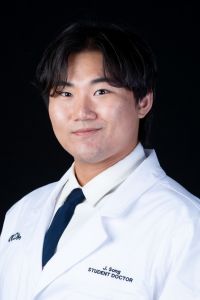Fluent in Compassion: Because Every Patient Deserves to Be Understood
Published May 13, 2025
Inside OME

By Joseph Song, OMS I, Orlando College of Osteopathic Medicine
I’m a Korean American who came to the United States at the age of 14. My American journey began in Montgomery County, Maryland, where I attended high school while living with my older brother. Our parents visited only a few times a year, so we had to learn how to navigate life on our own at a young age.
After high school, I went on to study at UC San Diego for my undergraduate degree, then enrolled in pharmacy school at UC Irvine. However, I realized my true passion was to become a physician, so I made the difficult decision to leave pharmacy school and pursue medical school instead. Today, I’m studying at the Orlando College of Osteopathic Medicine in Florida.
I don’t want to begin this piece with negativity, but I do want to acknowledge the very real challenges that many minorities—especially immigrant students—face. Not many people in my community pursue the path to medical school as a 1.5-generation immigrant. I often felt like I didn’t have a clear roadmap. I didn’t have family members or close friends who were educated in the United States, so I had to find resources, build networks and figure things out on my own.
But in the process, I developed resilience. I learned to value the people around me and surrounded myself with supportive, inspiring individuals. Still, there were moments I almost gave up. I felt like an outsider—different from the "average" medical school student. I didn’t fit the mold. But as I began meeting more people at conferences and events, I realized that every student has a unique background. I wasn’t alone. I was part of a broader, diverse community, and we all had something valuable to contribute.
When I was younger, I struggled with being different. English wasn’t my first language, and I often felt like my cultural background made it harder to connect with others. But over time, I realized that these differences are not weaknesses—they’re strengths, especially in the world of healthcare.
Through my experiences, particularly within the Asian immigrant community, I’ve seen how language barriers and unfamiliarity with the healthcare system can prevent people from getting the care they need. I remember how overwhelming it was when I first arrived in the United States—I didn’t speak English, and I didn’t know how to navigate the system. Many immigrants feel the same fear. They’re afraid to visit a doctor or pharmacist because they’re anxious about not being understood.
I’ve worked with patients who were clearly nervous—not just because of their medical conditions, but because they feared being judged for their English. It’s something I deeply relate to. I’ve felt the same anxiety and self-consciousness. But I’ve also learned that empathy, patience and a simple smile can break through those walls.
One experience I’ll never forget happened while I was working as a pharmacy intern. Many of our patients didn’t speak English, and I could tell they were worried—not just about their prescriptions, but about being misunderstood or dismissed. I made it a point to take time with each person, to listen carefully and to communicate with kindness. Even though I was just an intern, patients would return asking for me. That showed me how powerful compassion can be.
Here’s what I want to leave you with: the United States is built on diversity. It’s one of our greatest strengths. But we must recognize that the immigrant experience can be full of obstacles, especially in healthcare. For some of us, these are everyday interactions—but for our patients, it might be a life-changing moment. As healthcare professionals, we can make a huge impact by simply being aware, welcoming and understanding.
I’m grateful to AAPI Heritage Month for bringing attention to these stories and encouraging conversations about inclusion. We all grow stronger when we embrace diversity—and I’m proud to be part of that journey.
